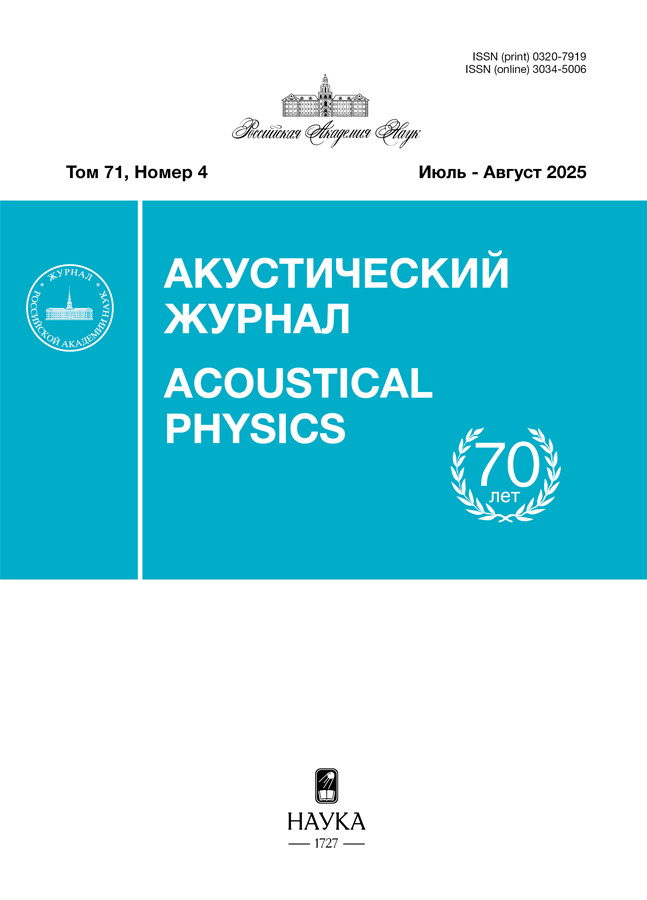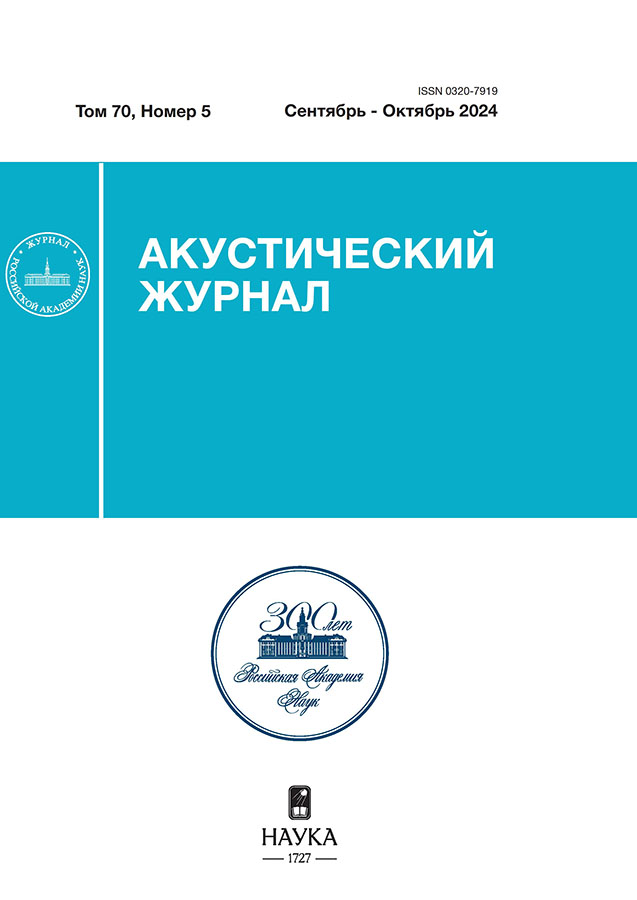Импульсный источник возбуждения в речевом сигнале
- Авторы: Сорокин В.Н.1
-
Учреждения:
- Институт проблем передачи информации РАН
- Выпуск: Том 70, № 5 (2024)
- Страницы: 778-794
- Раздел: ОБРАБОТКА АКУСТИЧЕСКИХ СИГНАЛОВ. КОМПЬЮТЕРНОЕ МОДЕЛИРОВАНИЕ
- URL: https://rjpbr.com/0320-7919/article/view/648445
- DOI: https://doi.org/10.31857/S0320791924050121
- EDN: https://elibrary.ru/XBBEKN
- ID: 648445
Цитировать
Полный текст
Аннотация
Свойства речевого взрыва смычки исследуются на материале базы данных 39 дикторов, содержащей однозначные и многозначные числительные с параллельной записью сигналов на телефонную трубку и направленный микрофон. Детектирование речевого взрыва выполняется кратковременным и долговременным детектором спектрально-временных неоднородностей, а также детектором меры сходства собственных функций спектра взрыва согласных и текущего спектра речевого взрыва. Вероятность присутствия звонкой или глухой смычки оценивается в пространствах амплитудного спектра и спектра групповой задержки по отношению энергии в области высоких и низких частот. Место артикуляции заднеязычного согласного влияет на распределения вероятности длительности интервала между началом речевого взрыва и началом гласного, частоты пика с максимальной амплитудой в высокочастотной области, отношения энергии в области высоких и низких частот спектра речевого взрыва, а также меры сходства собственных функций спектра взрыва согласного и текущего спектра речевого взрыва.
Полный текст
Об авторах
В. Н. Сорокин
Институт проблем передачи информации РАН
Автор, ответственный за переписку.
Email: vns@iitp.ru
Россия, Москва
Список литературы
- Jongman A., Miller J.D. Method for the location of burst-onset spectra in the auditory-perceptual space: A study of place of articulation in voiceless stop consonants // J. Acoust. Soc. Am. 1991. V. 89. N 2. P. 867–873.
- Bonneau A., Djezzar L., Laprie Y. Perception of the place of articulation of French stop bursts // J. Acoust. Soc. Am. 1996. V. 100. P. 555–564.
- Dorman M.F., Studdert-Kennedy M., Raphael L. Stop-consonant recognition: Release bursts and formant transitions as functionally equivalent, context-dependent cues // Perception & Psycophysics. 1977. V. 2. N 2. P. 109–122.
- Stevens K., Blumstein S. Invariant cues for place of articulation in stop consonants // J. Acoust. Soc. Am. 1978. V. 64. P. 1358–1368.
- Blumstein S., Stevens K. Acoustic invariance in speech production: evidence from measurements of the spectral characteristics of stop consonant // J. Acoust. Soc. Am. 1979. V. 66. P. 1001–017.
- Ohde R.N., Stevens K.N. Effect of burst amplitude on the perception of stop consonant place of articulation // J. Acoust. Soc. Am. 1983. V. 74. P. 706–714.
- Steinschneider M., Fishman Y.I., Arezzo J.C. Representation of the voice onset time (VOT) speech parameter in population responses within primary auditory cortex of the awake monkey // J. Acoust. Soc. Am. 2003. V. 114. N 1. P. 307–321.
- Sharma A., Dorman M.F. Cortical auditory evoked potential correlates of categorical perception of voice-onset time // J. Acoust. Soc. Am. 1999. V. 106. N 2. P. 1078–1083.
- Steinschneider M., Volkov I.O., Noh M.D., Garell P.C., Howard III M.A. Temporal encoding of the voice onset time phonetic parameter by field potentials recorded directly from human auditory cortex// J. Neurophysiol. 1999. V. 82. P. 2346–2357.
- Blumstein S.E., Myers E.B., Rissman J. The Perception of Voice Onset Time: An fMRI Investigation of Phonetic Category Structure // J. Cognitive Neuroscience. 2005. V. 17. N 9. P. 1353–1366.
- Rimol L.M., Eichele T., Hugdahl K. The effect of voice-onset time on dichotic listening with consonant-vowel syllables // Neuropsychologia. 2006. V. 44. N 2. P. 191–196.
- Auzou P., Ozsancak C., Hard R., Morris J., Jan M., Eueustache F., Hannequin D. Voice onset time in aphasia, apraxia of speech and dysarthria: a review // Clinical Linguistics & Phonetics. 2000. V. 14. N 2. P. 131–150.
- Min S.N., Park S.J., Im J.N., Subramaniyam M.A. Bayesian Model for Prediction of Stroke with Voice Onset // 3rd Int. Conf. on Advances in Mechanical Engineering (ICAME2020). IOP Conf. Series: Materials Science and Engineering. 2020. 912(6). 062003. https://doi.org/10.1088/1757–899X/912/6/062003
- Johansson I.-L., Samuelsson Ch., Müller N. Consonant articulation acoustics and intelligibility in Swedish speakers with Parkinson’s disease: a pilot study // Clinical Linguistics & Phonetics. 2023. V. 37. N 9. P. 845–865.
- Lisker L., Abramson A. A cross-language study of voicing in initial stops: Acoustical measurements // Word. 1964. V. 20. P. 384–422.
- Ladefoged P., Madison I. The sounds of the world’s languages. Blackwell Publishing, 1996.
- Cho T., Ladefoged P. Variation and Universals in VOT: Evidence from 18 Languages // J. Phonetics. 1999. V. 27. P. 207–229.
- Chodroff E., Golden A., Wilson C. Covariation of stop voice onset time across languages: Evidence for a universal constraint on phonetic realization // J. Acoust. Soc. Am. 2019. V. 145 (1). EL109-EL115.
- Cho T., Whalen D.H., Docherty G. Voice onset time and beyond: Exploring laryngeal contrast in 19 languages // J. Phonetics. 2019. V. 72. P. 52–65.
- Winn M.B. Manipulation of voice onset time in speech stimuli: A tutorial and flexible Praat script // J. Acoust. Soc. Am. 2020. V. 147. N 2. P. 852–866.
- Fant G. Speech and Sounds. MIT Press, 1973.
- Robb M., Gilbert H., Lerman J. Influence of Gender and Environmental Setting on Voice Onset Time // Folia Phoniatrica et Logopaedica. 2005. V. 57. P. 125–133.
- Niyogi P., Ramesh P. The voicing feature for stop consonants: Recognition experiments with continuously spoken alphabets. // Speech Commun. 2003. V. 41. P. 349–367.
- Сорокин В.Н. Синтез речи. М.: Наука, 1992.
- Winn M.B., Chatterjee M., Idsardi W.J. The roles of voice onset time and F0 in stop consonant voicing perception: Effects of masking noise and low-pass filtering // J. Speech Lang. Hear. Res. 2013. V. 56. N 4. P. 1097–1107.
- Yu V., De Nil L., Pang E. Effects of age, sex and syllable number on voice onset time: Evidence from children’s voiceless aspirated stops // Language and Speech. 2015. V. 58. N 2. P. 152–167.
- Stouten V., Van Hamme H. Automatic Voice Onset Time Estimation from Reassignment Spectra // Speech Communication. 2009. V. 51. N12. P. 1194–1205.
- Hansen J.H.L., Gray Sh.S., Kim W. Automatic voice onset time detection for unvoiced stops (/p/, /t/, /k/) with application to accent classification // Speech Communication. 2010. V. 52. P. 777–789.
- Lin Ch.-Y., Wang H.-Ch. Automatic estimation of voice onset time for word-initial stops by applying random forest to onset detection // J. Acoust. Soc. Am. 2011. V. 130. N 1. P. 514–525.
- Sonderegger M., Keshe J. Automatic Discriminative Measurement of Voice Onset Time // J. Acoust. Soc. Am. 2012. V. 132. N 6. P. 3965–3979.
- Prathosha P., Ramakrishnan A.G., Ananthapadmanabha T.V. Estimation of voice-onset time in continuous speech using temporal measures // J. Acoust. Soc. Am. 2014. V. 136. N 2. EL122.
- Сорокин В.Н. Теория речеобразования. 1985.
- Stevens K.N. Acoustic phonetics. MIT, 1998.
- Сорокин В.Н. Детекторы артикуляторных событий // Акуст. журн. 2020. Т. 66. № 1. С. 71–85.
- Patterson R.D., Holdsworth J. A functional model of neural activity patterns and auditory images // Advances in Speech, Hearing and Language Processing. 1996. V. 3. P. 547–563.
- Сорокин В.Н., Чепелев Д.Н. Первичный анализ речевых сигналов // Акуст. журн. 2005. Т. 51. № 4. С. 536–542.
- Whiteside S., Henry L., Dobbin R. Sex differences in voice onset time: A developmental study of phonetic context effects in British English // J. Acoust. Soc. Am. 2004. V. 116. N 2. P. 1179–1183.
- Sussman H.M., McCaffrey H.A., Matthews S.A. An investigation of locus equations as a source of relational invariance for stop place categorization // J. Acoust. Soc. Am. 1991. V. 90. P. 1309–1325.
- Iskarous Kh., Fowler C.A., Whalen D.H. Locus equations are an acoustic expression of articulator synergy // J. Acoust. Soc. Am. 2010. V. 128. N 4. P. 2021–2032.
- Montgomery A., Reed P.E., Crass K.A., Hubbard H.I., Stith J. The effects of measurement error and vowel selection on the locus equation measure of coarticulation // J. Acoust. Soc. Am. 2014. V. 136. N 5. P. 2747–2750.
- Речь. Артикуляция и восприятие. М.: Наука, 1965.
- Klatt D.H. Linguistic uses of segmental duration in English sentences // J. Acoust. Soc. Am. 1976. N 5. P. 1208–1221.
- Olson D.J. Phonetic feature size in second language acquisition: Examining VOT in voiceless and voiced stops // Second Language Research. 2022. V. 38(4). P. 913–940.
Дополнительные файлы


























